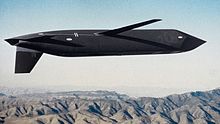AGM-129 ACM
| AGM-129 Advanced Cruise Missile | |
|---|---|
 |
|
| Type | Air-launched cruise missile |
| Place of origin | United States |
| Service history | |
| In service | June 1990 – 2012 |
| Used by | U.S. Air Force (decommissioned) |
| Production history | |
| Manufacturer |
General Dynamics (initially) Raytheon Missile Systems |
| Produced | July 1985 |
| Specifications | |
| Weight | 3,500 lb (1,300 kg) |
| Length | 20 ft 10 in (6.35 m) |
| Diameter | 2 ft 5 in (705 mm) |
| Warhead | W80-1 nuclear warhead |
|
|
|
| Engine | Williams International F112-WR-100 Turbofan |
| Wingspan | 10 ft 2 in (3.1 m) |
|
Operational
range |
2,000 nautical miles (3,700 km) |
| Speed | 500 mph (800 km/h) |
|
Guidance
system |
Inertial guidance system enhanced with Lidar and Terrain Contour Matching (TERCOM). |
|
Launch
platform |
B-52 Stratofortress |
The AGM-129 ACM (Advanced Cruise Missile) was a low-observable, subsonic, turbofan-powered, air-launched cruise missile originally designed and built by General Dynamics and eventually acquired by Raytheon Missile Systems. Prior to its withdrawal from service in 2012, the AGM-129A was carried exclusively by the US Air Force's B-52H Stratofortress bombers.
In 1982 the US Air Force began studies for a new cruise missile with low-observable characteristics after it became clear that the AGM-86B cruise missile would have difficulty penetrating future air defense systems. The AGM-86B relied on low-altitude flight to penetrate the Soviet air defense system centered on surface to air missiles. The deployment of the airborne early warning systems, together with the Zaslon PESA radar on Mig-31 and Myech radar on Su-27 interceptors, all three "look-down/shoot-down" radars, reduced the likelihood that the low-altitude AGM-86B would reach its target.
The solution was to incorporate various "low-observable" ('stealth') technologies into a new Advanced Cruise Missile system.
In 1983 General Dynamics Convair Division (GD/C) was awarded a development contract for the AGM-129A (the losing design was Lockheed Corporation's Senior Prom). The AGM-129A incorporated body shaping and forward swept wings to reduce the missile's radar cross section. The engine air intake was flush mounted on the bottom of the missile to further improve radar cross section. The jet engine exhaust was shielded by the tail and cooled by a diffuser to reduce the infrared signature of the missile. To reduce electronic emissions from the missile, the radar used in the AGM-86B was replaced with a combination of inertial navigation and terrain contour matching TERCOM enhanced with highly accurate speed updates provided by a Lidar Doppler velocimeter.
...
Wikipedia
